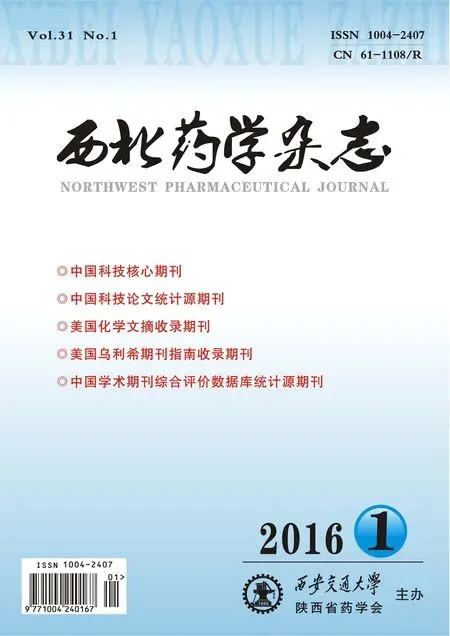辣椒碱药理作用的分子机制研究进展
王荣雁,陈朝军,武世奎,高丽娜,周 南
(内蒙古医科大学药学院,呼和浩特 010110)
辣椒碱药理作用的分子机制研究进展
王荣雁,陈朝军*,武世奎,高丽娜,周南
(内蒙古医科大学药学院,呼和浩特010110)
摘要:目的对近年来辣椒碱的药理活性及其分子的作用机制进行综述,提高对辣椒碱的研究水平。方法查阅大量国内外文献,总结、提炼并阐明辣椒碱的应用前景。结果辣椒碱具有镇痛、抗癌、心血管保护以及碱脂活性作用。研究发现TRPV1受体对辣椒碱药效的发挥起到了关键作用。结论预见辣椒碱在抗癌、心血管保护方面有巨大的新药开发前景。
关键词:辣椒碱;抗癌;心血管保护;药理作用
辣椒碱(C18H27NO3,反-8-甲基-N-香草基-6-壬烯酰胺)是从辣椒属植物中提取的生物碱类[1],具有辛辣气味且难溶于水。市售辣椒碱主要有2种来源,一是以香草素与7-亚甲基-5-烯-1-羧酸酰氯反应合成,二是从辣椒干燥果实中提取分离,二者药理活性一致。辣椒碱透皮贴剂作为缓解神经痛类临床处方药,已被美国药典24版收载。Peppin J F[2]由实验得出,8%辣椒碱透皮贴剂治疗外周神经痛,镇痛效果明显,且不会带来阿片类镇痛药样的亢奋等不良反应。近年来有关辣椒碱临床应用的研究发现,其在治疗抗癌、肥胖、以及心血管疾病方面都发挥着积极作用,且这些作用的产生与TRPV1受体的激活存在着密切的关系。
1TRPV1受体
TRPV1是瞬时感受器电位超家族离子通道亚家族TRPV中的成员,TRPV由TRPV1~TRPV6组成。其中TRPV1~TRPV4是非选择性阳离子通道,能被高温激活,而TRPV5~TRPV6是单纯的高选择性Ca2+依赖型通道[3]。目前,TRPV1是受到关注较多的受体之一;该受体主要在周围神经系统和中枢神经系统的神经元中表达,参与伤害性高温及痛觉刺激引起的生理反应[4]。有研究表明,TRPV1受体在皮肤角膜、膀胱、肺、呼吸道也有表达[5-6]。高温及一些内源性、外源性配体能够激活TRPV1受体,并参与降温及一些其他的生理反应。具有镇痛作用的辣椒碱则是作为外源性配体激活TRPV1受体从而在体内发挥其药效。
2辣椒碱介导TRPV1受体作用机制
2.1镇痛机制TRPV1又称辣椒碱受体,参与人体的温觉感受[7],广泛分布于大鼠及人的脑细胞中[8]。选择特定的核糖核酸探针对大鼠脑细胞中TRPV1的表达进行探测,经反转录-聚合酶链反应(RT-PCR)证实,TRPV1在皮质、海马、纹状体、下丘脑、小脑等都有表达。Giordano C[9]在实验中证明了TRPV1参与痛觉感受,神经痛引起前额叶皮层和下边缘皮层活动改变,谷氨酸纤维通过基底外侧杏仁核、内侧前额叶皮质(mPFC)神经元增强TRPV1兴奋性,随后谷氨酸在细胞外的水平增加,这有助于对有害刺激的处理。
辣椒碱竞争性抑制TRPV1活性,从而使节前纤维对各种刺激,如物理刺激、内源性、外源性化学刺激以及炎症因子刺激均无应答[10]。从分子学水平上说辣椒碱导致细胞外钙依赖性受体蛋白构型发生变化,钙通道关闭使刺激无应答[11]。一定浓度的辣椒碱激活TRPV1,使其释放感觉神经肽[12],辣椒碱通过阻断P物质和感觉神经元内生长抑制激素的轴浆运输而阻止神经肽恢复,由此神经肽被消耗而浓度下降,从而达到缓解疼痛效果。辣椒碱不单是通过耗尽神经肽物质,而是通过一系列机制导致痛觉纤维的功能丧失(功能丧失包括膜电位下降、神经肽耗尽、无法运送神经营养因子、表皮和真皮神经纤维末端可逆收缩)。TRPV1刺激传入神经导致的机能丧失致使整个神经元长期功能和表型改建。然而,辣椒碱能损伤感觉神经,反复局部用药会引起皮肤自主神经纤维退化,对痛觉敏感程度下降[13]。
2.2抗癌机制最近一系列研究结果显示,辣椒碱激活TRPV1使细胞内钙离子浓度增加,一定程度上也加速了肿瘤细胞的凋亡。
Han Bai等[14]采用注射蛙皮素方法诱导小鼠发生慢性胰腺炎和胰腺上皮内肿瘤病变,根据炎细胞浸润、间质纤维化以及腺泡极性损失等指标判断小鼠感染了胰腺炎,进一步发生胰腺上皮内肿瘤病变,当以一定剂量辣椒碱处理被诱导小鼠8周后,增殖细胞核标记的细胞增殖显著下降,细胞外信号调节激酶磷酸化得到显著抑制。由此得出辣椒碱通过抑制胰腺炎、K-ras基因突变达到了预防胰腺癌的效果。
辣椒碱能诱导胰腺癌[15]、骨瘤细胞癌[16]、膀胱癌[17]、胆管癌[18]等癌细胞凋亡,抗癌效果明显。在辣椒碱诱导小细胞肺癌细胞(SCLC)凋亡的实验中表明[19],辣椒碱对SCLC促凋亡作用不是受辣椒碱受体TRPV1支配,而是由TRPV6介导的。在这项实验中发现,正常肺细胞中TRPV6表达远远低于SCLC中TRPV6表达,因此辣椒碱通过激活TRPV6而诱导的肺癌细胞凋亡机制对正常细胞损伤程度极低,更有利于临床上小细胞肺癌的治疗。
线粒体是细胞凋亡的控制中心。线粒体膜电位降低,外膜通透性变高释放细胞色素C,细胞色素C在dATP存在下与凋亡相关因子(Apaf)结合,形成多聚体后与caspase-9结合成凋亡小体,进而激活caspase-3诱导细胞凋亡。线粒体还能释放一些凋亡诱导因子,如AIF,参与细胞凋亡。辣椒碱作为抗肿瘤药物的作用机制是通过作用于线粒体,促使人咽鳞癌细胞[20]、肝癌细胞[21]、结肠癌细胞[22]、乳腺癌细胞[23]的生长周期停滞于G1、G2期,进而抑制细胞增殖,促进细胞凋亡。此外,Kathleen C. Brown等[24]在研究以辣椒碱对抗人小细胞肺癌的增殖实验中发现,辣椒碱抗增殖活性与蛋白质内E2F转录因子、细胞周期蛋白质E表达能力下降有关。
2.3减肥机制肥胖是近年来威胁人类健康的巨大隐患。2008年Arianne L. Motter等[25]对TRPV1缺失的小鼠及正常小鼠饲喂高脂饲料,显示TRPV1缺失小鼠的脂肪新陈代谢速率明显高于正常小鼠,对TRPV1敏感的神经可能与调节脂肪代谢有关。Yu Q等[26]在研究辣椒碱对兔子(与人类TRPV1基因序列更接近)肥胖抑制作用中发现,食用辣椒碱可以减少饮食诱导的肥胖发生。Leung F W[27]在研究中发现服用辣椒碱可以增加脂联素及其受体的表达,从而降低肥胖大鼠的代谢异常。TRPV1在脂肪组织和373-L1脂肪细胞中都有表达,TRPV1受体能通过抑制前脂肪细胞向成熟细胞分化,负向调控脂肪细胞分化成熟从而阻止脂肪的生成。
2.4其他药理活性机制TRPV1分布在心肌血管靠近心外膜[28]和血管内皮细胞[29]的感觉神经中。当心肌回血量下降会激动TRPV1释放活性氧自由基,TRPV1通过神经肽的释放在血流血压中起调节作用。血管舒张是由神经元和TRPV1激动引起的血管效应机制共同作用的结果,感觉神经中TRPV1激动,释放降血钙素基因肽(CGRP),引起血管舒张。就血管机制而言,激动TRPV1导致蛋白激酶A和上皮细胞一氧化氮合酶释放,从而释放一氧化氮,使血管舒张[30]。研究显示[31],TRPV1参与心肌梗死引发的胸部刺痛,对非缺血性心脏伤害有保护作用。
E. Ternesten-Hasseus等[32]在一组临床试验中发现,服用辣椒碱可减轻环境刺激引起的慢性咳嗽,且该结果具有统计学意义,然而其作用机制尚在研究中,可能是由辣椒碱激活TRPV1通道引起的。
3辣椒碱类似物
CH-19甜在美国和日本以天然辣椒素酯命名,含有天然辣椒素酯类物质DHC约20%。Sasahara I等[33]通过实验证明,CH-19甜中所含辣椒素酯(CST)、二氢辣椒素酯(DTC)、降二氢辣椒素酯(NDTC)与辣椒碱中所含该类物质具有相似的生物学效价,且对小鼠眼部、内脏几乎无毒性作用。灌胃CH-19甜可增加小鼠耗氧量,提高能量脂肪氧化。
4展望
目前,多项研究表明,辣椒碱在临床方面有广泛的应用前景,然而这些发现尚处于起步阶段。辣椒碱在肾结石所引起的疼痛、痛风、紧张性头痛等方面的应用还需要进一步研究,现已报道文献中缺乏安全性和临床应用方面的审查。辣椒碱因其低亲和力、高亲脂性、弱效力使其在临床应用方面受到限制。辣椒碱具有强烈的灼烧感,病人顺应性差。若将辣椒碱封装在脂质体[34]内制成微囊或采用电离子导入法,可避免其灼热刺激。将纳米技术应用于辣椒碱缓释制剂的制备,或将纳米辣椒碱联合其他药物如抗癌药物,可能会增强抗癌药物的治疗效果。
参考文献:
[1] 苏良飞,周仲承,王克军,等. 天然辣椒碱提取方法研究进展[J]. 西北药学杂志,2010,25(4):封2-3.
[2]Peppin J F,Majors K, Webster L R, et al. Tolerability of NGX-4010,a capsaicin 8% patch for peripheral neuropathic pain[J]. J Pain Res,2011,4: 385-392.
[3]Nilius B,Owsianik G,Voets T,et al. Tranisient receptor potential cation chann-els in disease[J]. Physiol Rec,2007,87(1): 165-217.
[4]Mickle A D,Shepherd A J,Mohapatra D P. Sensory TRP channels: the key transducers of nociception and pain[J]. Prog Mol Biol Transl Sci,2015,131: 73-118.
[5]Cavanaugh D J,Lee H,Lo L,et al. Distinct subsets of unmyelinated primary sensory fibers mediate behavioral responses to noxious thermal and mechanical stimuli[J]. Proc Natl Acad Sci USA,2009,106(22): 9075-9080.
[6]Kobayashi K1, Fukuoka T,Obata K,et al. Distinct expression of TRPM8, TRPA1, and TRPV1 mRNAs in rat primary afferent neurons with adelta/c-fibers and c-olocalization with trk receptors[J]. J Comp Neurol,2005,493(4): 596-606.
[7]Cao E,Cordero-Morales J F,Liu B,et al. TRPV1 channels are intrisically heat sensitive and negatively regulated by phosphoinositide lipid [J]. Neuron,2013,77(4): 667-679.
[8]Mezey E,Toth Z E,Cortright D N,et al. Distribution of mRNA for vanilloid receptor subtype 1(VR1),and VR1-like immunoreactivity,in the central nervous system of the rat and human[J]. Proc Natl Acad Sci USA,2000,97(7): 3655-3660.
[9]Giordano C,Cristino L,Luongo L,et al. TRPV1-dependent and indepent alterations in the limbic cortex of neuropathic mice: impact on glial caspases and pain perception[J]. Cereb Cortex,2012,22(11): 2495-2518.
[10]Anand P,Bley K. Topical capsaicin for pain management: therapeutic potential and mechanisms of action of the new high concentration capsaicin 8% patch[J]. Br J Anaesth,2011,107(4): 490-502.
[11]Liu L,Simon S A. Capsaicin-induced currents with distinct desensitization and Ca2+dependence in rat trigeminal ganglion cells[J]. J Neurophysiol,1996,75(4): 1503 -1514.
[12]鹿晓文,寇亮,杜莉. 瞬时受体电位香草酸亚型1介导疼痛及其调节机制[J]. 国际口腔医学杂志, 2014,41(1): 82-87.
[13]Anon. Final report on the safety assessment of capsicum annuum extract, capsicum annuum fruit extract,capsicum annuum resin,capsicum annuum fruit powder,capsicum frutescens fruit,capsicum frutescens fruit extract,capsicum frutescens resin,and capsaicin[J]. Int J Toxicol, 2007,26(1): 3-106.
[14]Bai H, Li H, Zhang W, et al. Inhibition of chronic pancreatitis and pancreatic intraepithelial neoplasia (Pan I N) by capsaicin in LSL-KrasG12D/Pdx1-Cre mice[J]. Carcinogenesis,2011,32 (11): 1689-1696.
[15]Lin S, Zhang J, Chen H, et al. Involvement of endoplasmic reticulum stress in capsaicininduced apoptosis of human pancreatic cancer cells[J]. Evid Based Complement Alternat Med, 2013,2013: 629750.
[16]Cho W H,Lee H J,Choi Y J,et al. Capsaicin induces apoptosis in MG63 human osteosarcoma cells via the caspase cascade and the antioxidant enzyme system[J]. Mol Med Rep,2013,8(6): 1655-1662.
[17]D’Eliseo D,Manzi L, Velotti F. Capsaicin as an inducer of damage associated molecular patterns (DAMPs) of immunogenic cell death (ICD) in human bladder cancer cells[J]. Cell Stress Chaperones,2013,18(6): 801-808.
[18]S Baez,Y Tsuchiya,A Calvo,et al. Genetic variants involved in gallstone formation and capsaicin metabolism,and the risk of gallbladder cancer in Chilean women[J]. World J Gastroenterol,2010,3(16): 372-378.
[19]Lau J K,Brown K C ,Dom A M ,et al. Capsaicin induces apoptosis in human small cell lung cancer via the TRPV6 receptor and the calpain pathway[J]. Apoptosis,2014,19(8): 1190-1201.
[20]Le T D,Jin D,Rho S R,et al. Capsaicin-induced apoptosis of FaDu human pharyngeal squamous carcinoma cells[J]. Yonsei Med J,2012,53(4): 834-841.
[21]Impheng H, Pongcharoen S, Richert L,et al. The selective target of capsaicin on FASN expression and De novo fatty acid synthesis mediated through ROS generation triggers apoptosis in HepG2 cells[J]. PLoS ONE,2014,9(9): e107842.
[22]Junzhe Jin,Guofu Lin,Hong Huang,et al. Capsaicin mediates cell cycle arrest and apoptosis in human colon cancer cells via stabilizing and activating p53[J]. Int J Biol Sci, 2014,10(3): 285-295.
[23]Lin C,Lu W,Wang C,et al. Capsaicin induces cell cycle arrest and apoptosis in human KB cancer cells[J]. BMC Complement Altern Med,2013,13: 46.
[24]Brown K C,Witte T R,Hardman W E,et al. Capsaicin displays anti-proliferative activity against human small cell lung cancer in cell culture and nude mice models via the E2F pathway[J]. PLoS ONE,2010,5(4): e10243.
[25]Arianne L Motter,Gerard P Ahern. TRPV1-null mice are protected from diet-induced obesity[J]. FEBS Lett,2008,582(15): 2257-2262.
[26]Yu Q,Wang Y,Yu Y,et al. Expression of TRPV1 in rabbits and consuming hot pepper affects its body weight[J]. Mol Biol Rep,2012,39(7): 7583-7589.
[27]Leung F W. Capsaicin as an anti-obesity drug[J]. Prog Drug Res, 2014,68: 171-179.
[28]Zahner M R,Li D P,Chen S R,et al. Cardiac vanilloid receptor 1-expressing afferent nerves and their role in the cardiogenic sympathetic reflex in rats[J]. J Physiol,2003,551(Pt2): 515-523.
[29]Poblete I M,Orliac M L,Briones R,et al. Anandamide elicits an acute release of nitric oxide through endothelial TRPV1 receptor activation in the rat arterial mesenteric bed[J]. J Physiol,2005,568(pt2): 539-551.
[30]Yang D,Luo Z,Ma S,et al. Activation of TRPV1 by dietary capsaicin improves endothelium dependent vasorelaxation and prevents hypertension[J]. Cell M-etab,2010,12(2): 130-141.
[31]Pan H L,Chen S R. Sensing tissue ischemia:another new function for capsaicin receptors[J]. Circulation,2004,110(13): 1826-1831.
[32]Ternesten-Hasseus E,Johansson E L,Millqvist E,et al.Cough reduction using capsaicin[J]. Respir Med,2015,109(1): 27-37.
[33]Sasahara I,Furuhata Y,Iwasaki Y,et al. Assessment of the biological similarity of three capsaicin analogs (Capsinoids) found in non-pungent chili pepper (CH-19Sweet) fruit[J]. Biosci Biotechnol Biochem,2010,74(2): 274-278.
[34]张爱军,封新,马小亚,等. 辣椒素脂质体凝胶剂的制备与释放度的测定[J]. 西北药学杂志,2011,26(4): 279-280.
Recent advances in molecular mechanisms of capsaicin′s pharmacological effect
WANG Rongyan,CHEN Chaojun*,WU Shikui,GAO Lina,ZHOU Nan(College of Phanmacy, Inner Mongonlia Medical University,Hohhot 010110,China)
Abstract:ObjectiveTo review the recent pharmacological action and phamacokinetics researches of capsaicin both domestic and abroad. MethodsRecent literatures were summarized and analyzed. ResultCapsaicin has the analgesic,anti-cancer,cardiovascular protective and reducing fat effect. Recent studies found that capsaicin receptor TRPV1 plays a key role in its pharmacological effects. ConclusionIt is anticipated that capsaicin has great prospects for new drugs development in anticancer and cardiovascular protection.
Key words:capsaicin;anti-cancer;cardiovascular protection;pharmacological effects
收稿日期:(2015-04-20)
通信作者:*陈朝军,女,教授
作者简介:王荣雁,女,在读硕士研究生
中图分类号:R965
文献标志码:A
文章编号:1004-2407(2016)01-0108-03
doi:10.3969/j.issn.1004-2407.2016.01.034

